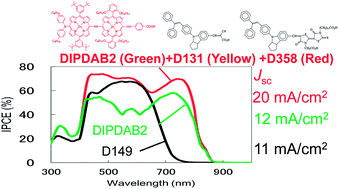Improved conversion efficiency of 10% for solid-state dye-sensitized solar cells utilizing P-type semiconducting CuI and multi-dye consisting of novel porphyrin dimer and organic dyes†
Abstract
To realize highly efficient solid-state dye-sensitized solar cells (SDSCs), the absorption range of the dye should be extended to the near-IR range to increase short-circuit current density (Jsc); a high Jsc in turn requires a highly conductive p-type semiconductor. A newly developed dye (DIPDAB2) with a porphyrin dimer structure provided higher absorption coefficients than the conventional dye with a similar framework (DTBC) in the long wavelength range of 700–800 nm, leading to higher incident photon-to-current conversion efficiencies. The dip in the absorption spectrum of DIPDAB2 located at 500–700 nm between the Soret band and Q band was filled by combining with two kinds of organic dyes (D131 and D358). The multi-dye consisting of the three dyes realized a high Jsc over 20 mA cm−2. The use of copper iodide that has a higher conductivity than p-type organic semiconductors and copper complexes secured a high filling factor. Introduction of Li ions into the TiO2 photoelectrodes improved the open-circuit voltage (Voc) along with a slight increase in Jsc. Light soaking also contributed to a higher Voc. The conversion efficiency of the present SDSC was as high as 10%.



 Please wait while we load your content...
Please wait while we load your content...